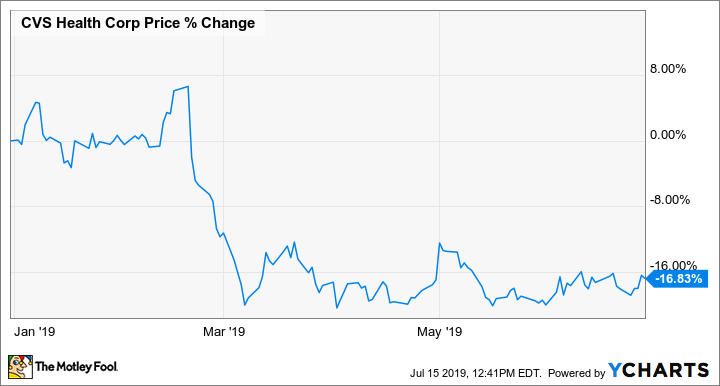Why CVS Health Stock Lost 17% Through the First Half of 2019
What happened
Despite a bull market this year and strong gains in the S&P 500, CVS Health (NYSE: CVS) nonetheless gave up 17% in the first six months of 2019, according to data from S&P Global Market Intelligence, as the company gave weak earnings guidance for 2019 and faced questions about reimbursement rates and its Aetna acquisition.
As you can see from the chart below, CVS stock fell sharply through late February and early March after the company offered a disappointing outlook for 2019.
So what
CVS stock fell 8% on Feb. 20 after its fourth-quarter earnings came out. The company actually beat expectations, posting revenue growth of 12.5%, boosted by the Aetna acquisition, to $54.4 billion, ahead of estimates at $53.76 billion. And adjusted earnings per share rose from $1.92 to $2.14, topping expectations of $2.06.

Image source: CVS.
However, investors were thrown off by the pharmacy chain's outlook for 2019. It projected adjusted EPS of just $6.68 to $6.88, down from $7.08 in 2018 and well below the analyst consensus at $7.34. Its first-quarter EPS guidance of $1.49 to $1.53 was also short of estimates at $1.67. Management said that 2019 would be a transitional year for the company and that it was "aware of certain headwinds," including pharmacy reimbursement rates, and it acknowledged a declining benefit from new generics and lower brand inflation.
Following the earnings report, the stock continued to slide as rival Walgreen's warned on reimbursement rates and signaled that it might not meet its full-year earnings guidance, showing headwinds across the industry.
CVS briefly regained some of those losses when it reported first-quarter earnings on May 1, rising 5.4% as the company beat estimates on both top and bottom lines and raised its full-year adjusted EPS guidance to $6.75 to $6.90. Though the report seemed to ease some of the market's doubts about the Aetna acquisition and the company's path forward, the stock slipped in the days following the report and continued trading in the $51-to-$55 range it had been since March.
Now what
In July, the pharmacy chain got another boost after the Trump administration backed away from a plan to end certain drug rebates as part of its strategy to lower drug prices. That was good news for CVS, the nation's largest pharmacy benefits manager, which gained 4.7% on July 11 when the news broke.
The stock continues to look like a value play, trading at a P/E under 9 based on this year's earnings, with management promising $800 million in synergies from the Aetna acquisition and double-digit earnings growth by 2022. Though the market remains skeptical of the pharmacy industry for a number of reasons, including e-commerce competition and pressure on reimbursement rates, CVS stock should eventually bounce back.
More From The Motley Fool
Jeremy Bowman owns shares of CVS Health. The Motley Fool recommends CVS Health. The Motley Fool has a disclosure policy.

 Yahoo Finance
Yahoo Finance 
